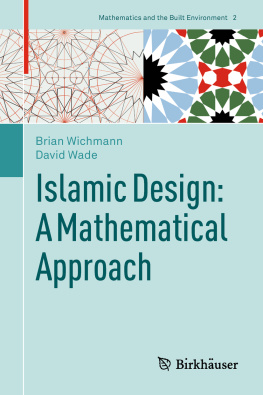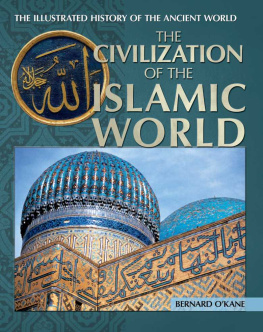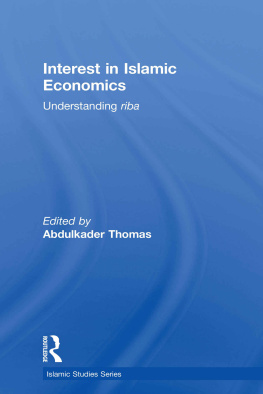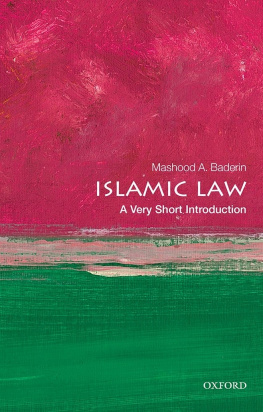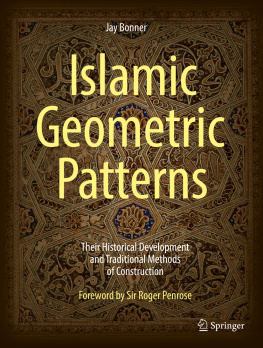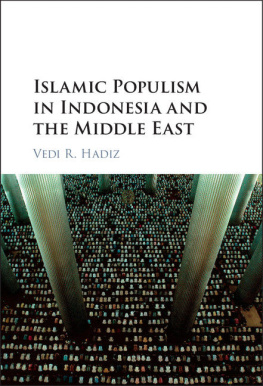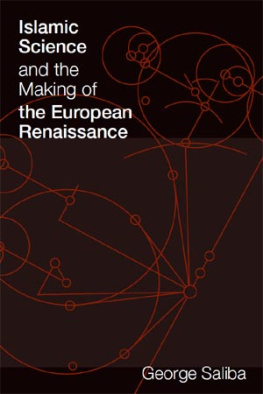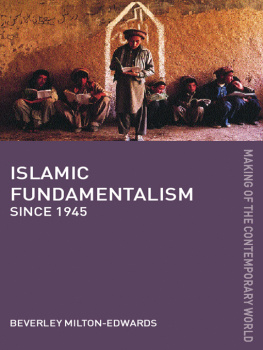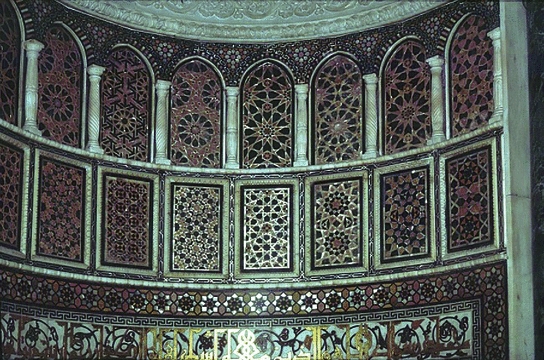The Great Mosque of Damascus, one of the oldest and most important mosques in the Islamic world, has a long and checkered history. Important to both the Sunni and Shia traditions, it presents decorative features from many periods, going back to the earliest, Umayyad dynasty when the influence of late classical tradition prevailed. This mihrab, of which the above is a detail, represents a virtual tour de force of geometric patterning. Dating from the medieval period, it has been carefully and lovingly restored, as befits such a masterpiece of architectural decoration.
Springer International Publishing AG, part of Springer Nature 2017
Brian Wichmann and David Wade Islamic Design: A Mathematical Approach Mathematics and the Built Environment
1. A History
The creation within the space of a single century of a vast Arab Empire stretching from Spain to India is one of the most extraordinary marvels of history.
J.J. Saunders, A History of Medieval Islam (Saunders 1965, p. 39)
1.1 The Revelations
The bare historical facts concerning the origin of the religion of Islam are theseThe Qurn, the Holy Book of Islam, began to be revealed to the Prophet Muhammad when he was forty years old, circa 610. These revelations continued until his death in 632, by which time their strict monotheistic message had become so widely accepted that the new religion had largely supplanted the ancient paganism of the Arabian Peninsula . The rapid, widespread acceptance of Islam also introduced a quite new sense of unity among the various Arabian tribes. For a list of key dates, see Appendix B.
This unity and sense of religious purpose was disturbed by the death of Muhammad, but after a short period of uncertainty his successors (in Arabic, Khalifah ) continued his mission, with an expansive programme of conversion, diplomacy and military tactics. The first Caliph, Abu Bakr , defeated various tribal rebellions that followed the Prophets death and managed to hold the Islamic community together. In 634 he called for a jihad (Holy War) to spread the Faith beyond the Arabian borders. In this enterprise the new religion was to prove extraordinarily successful.
1.2 Early Conquests
The decision to expand the mandate of Allah outwards, to the north and east, inevitably meant that the Muslims would confront the great Empires of Byzantium and Persia . In fact the timing, from their point of view, was propitious since these rival civilisations had been engaged in an exhausting war with each other for some twenty-five years (603628), as a result of which the resources of both were seriously depleted. The military successes of the upstart Arabs against the military might of both the Byzantine and Persian armies were quite remarkable. Damascus , the most important town in the Byzantine Middle-East, had capitulated by 635, the rest of Syria by 636. For the native Syrians, both Christians and Jews , this change of rulership was not altogether unwelcome, since it represented a release from Byzantine tyrannyanother reason for the success of Islam in this region. Mesopotamia fell to the Arab forces in 637 and Egypt in 639. In the following decades Persia, Turkestan , the Indus Valley , North Africa and Spain would follow. Remarkably, the Islamic world was largely delineated within a century of the death of the Prophet. Naturally, the rapidity and scale of these early conquests were felt by the early Muslims as a vindication of the rightfulness of their beliefs; God was clearly on their side.
1.3 Islam and the Civilisations of the Ancient World
There had been great nomadic movements before and there were others after the Arab conquests, but the important difference between the Islamic expansion and all others was precisely the intense collective conviction that was inspired by their newly-found faith. Fired as they were by religious zeal, these essentially unlettered nomads were able to withstand a complete absorption into the more sophisticated civilisations that had fallen into their lap. From the beginning, their mission was not merely destructive; they had a mission to reinvigorate the Abrahamic religion where it already existed (in the Hellenised, Christian remnants of the Eastern Roman Empire), and introduce it where it did not (in the Persian Sassanid Empire, and beyond). So although the wealth and technical achievements of the civilisations that they conquered made a deep and lasting impression they were able to resist the ideological and religious values that they encounteredin fact they were supremely confident of the superiority of their own religious beliefs. However, they had less resistance to more general cultural influences. To retain their hold on the conquered territories, the Muslims had to adopt many of their civilised ways. They proved very adept at this, largely by retaining the existing administrative institutions (including taxation and bureaucracy). In short, they quickly learned everything that sedentary civilisations had to teach them that was necessary to consolidate their conquests.
1.4 The Umayyads and Damascus
Muhammad had made Mecca the religious centre of the Islamic world (a role that it still fulfils), but its geographical position made it too remote a location from which to rule the recently acquired territories. It was inevitable that the Islamic administrative centre of gravity would shift northwards. In 661, the role of Caliph was taken over by Muawiya , an able general who had led the campaigns against the Byzantines and who had governed Syria for some twenty years. Muawiya belonged to the Meccan clan of Omayya, so he and his descendants were known as the Umayyad, and they would continue to rule the new Islamic Empire from the ancient town of Damascus for almost a century. This period of Islamic history saw the extraordinary expansion referred to in the heading quote. There was a downside to this campaign; it has been said that under the Umayyad Caliphate Islam grew as a power, but decayed as a religion.
The military conquests certainly continued at a staggering pace; by 710 Muslim troops had conquered the whole of North Africa and were crossing the Straits of Gibraltar to Spain; by 714 it too had succumbed. At the very same time, the Arabs, having completely overcome Persia, were pushing east to Central Asia , which capitulated in 712, as did the Indus Valley in 713 (both of which have retained an allegiance to Islam ever since).
At the centenary of the Hegira then, a centrally-controlled Islamic Empire ruled over territories that stretched quite literally from Spain and the Atlantic coast of Africa to India and the borders of China . As it turned out, these were to be the limits of Islamic territorial expansion for many centuries to come. In the process of Islams transformation from a religious movement into an imperial one it had lost much of its early spirit of group solidarity and to some extent its sense of missionary purpose. Serious rifts and dissatisfactions began to appear in the body politic, and these tended to be directed towards the ruling Dynasty. The Umayyad Emperors had been very successful in taking over the administrative practices of the Greeks and Persians , but they had also adopted their somewhat despotic manners, becoming luxurious, remote and autocratic as a consequence. Despite their unprecedented achievement in creating such a vast Empire, the Umayyads provoked many discontents. The dissenting factions finally came together in 750, when the Umayyads were overthrown by a revolution.

